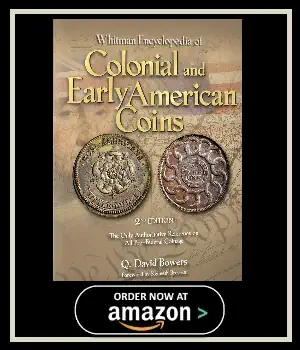Colonial Coinage in America
Popular Topics
• 1785 Bar Cent - A notable coin from the colonial period
• Early Colonial Currency - Understand the paper money used before federal standardization
Key Characteristics of Colonial Coinage
Foreign Coins in Colonial America
Foreign Coins: Colonists widely accepted various foreign currencies in daily transactions. Spanish pieces of eight, Dutch guilders, and Portuguese coins circulated freely throughout the settlements. Moreover, merchants valued these coins based on their metal content and perceived worth.
Colonial Tokens and Local Currency
Colonial Tokens: Individual colonies and private citizens created their own tokens when official coinage proved insufficient. Additionally, local traders typically crafted these copper tokens for regional commerce. Notable examples include Connecticut's Rosa Americana coinage and Massachusetts' Willow Tree series.
Notable Colonial Coin Series
Higley Copper (Early 1730s)
Higley Copper: Dr. Samuel Higley of Connecticut created these distinctive copper coins during the early 1730s. Interestingly, his designs featured unique motifs including beehives and harps. However, he produced them in limited quantities, making them exceptionally rare and valuable today.
Virginia Halfpenny (Mid-18th Century)
Virginia Halfpenny: Virginia's colonial government authorized these copper halfpennies to solve the small change shortage. Subsequently, the coins displayed King George II's image alongside the word "Virginia." Unfortunately, merchants rarely accepted them, resulting in their current scarcity.
Fugio Cent (1787)
Fugio Cent: Congress authorized these historic coins in 1787, marking America's first official currency step. Benjamin Franklin designed them with a sundial and "Fugio" motto, meaning "I fly" in Latin. Additionally, the reverse featured thirteen linked rings symbolizing colonial unity.
Massachusetts Bay Colony Coinage
Massachusetts Bay Colony pioneered coin production in British North America. Consequently, their efforts established important precedents for future colonial minting activities.
The Massachusetts Bay Colony Silver Coinage (1652)
Massachusetts Bay Colony (1652): Massachusetts produced the first coins in British North America during this pivotal year. The General Court authorized silver coinage featuring primitive, hand-cut designs. Furthermore, craftsmen created iconic tree designs on one side with denominations on the reverse.
The Tree Coinage Series
Willow Tree Coinage (1653-1660)
Willow Tree Coinage (1653-1660): Massachusetts continued minting efforts with this seven-year series following their initial success. Artisans featured willow trees on one side while displaying denominations on the reverse. However, crude production methods limited their widespread acceptance.
Oak Tree Coinage (1660-1667)
Oak Tree Coinage (1660-1667): This series succeeded the Willow Tree coinage with improved sophistication. Craftsmen featured oak trees prominently on the obverse side. Additionally, standardized designs marked significant progress in colonial minting techniques.
Pine Tree Coinage (1667-1682)
Pine Tree Coinage (1667-1682): Collectors consider this series among the most beautiful early colonial coinages. Pine trees dominated the obverse design while denominations appeared on the reverse. Moreover, this fifteen-year run demonstrated remarkable consistency in production quality.
Other Colonial Minting Efforts
Regional Colonial Coinages
Other Colonial Coinages: Connecticut, New Jersey, and Maryland also attempted independent coin production. Nevertheless, their efforts never achieved Massachusetts' widespread circulation success. Furthermore, most regional attempts remained limited to local markets.
British Regulatory Control
Regulatory Issues and British Control: British Crown authorities grew increasingly concerned about independent colonial currencies during this period. Consequently, they passed restrictive laws in the late 17th and early 18th centuries. These regulations effectively ended most colonial minting efforts, forcing greater reliance on British and foreign coins.
The Spanish Dollar Standard
Spanish Dollar as a Standard: Spanish dollars became the preferred currency throughout American colonies due to their consistent value and widespread acceptance. Subsequently, the Coinage Act of 1792 officially adopted the Spanish dollar as the foundation for America's new monetary system.
Historical Significance and Legacy
Establishing the U.S. Mint in 1792 marked a crucial turning point in American monetary history. This milestone led to standardized coin production for the new nation. Previously, diverse coins and tokens reflected the colonies' varied economic and cultural influences.
Colonial coinage history reveals the significant challenges of creating stable currency in a developing society. Moreover, dependence on foreign coins and eventual currency standardization after independence established the foundation for America's modern monetary system.



 '
' 




